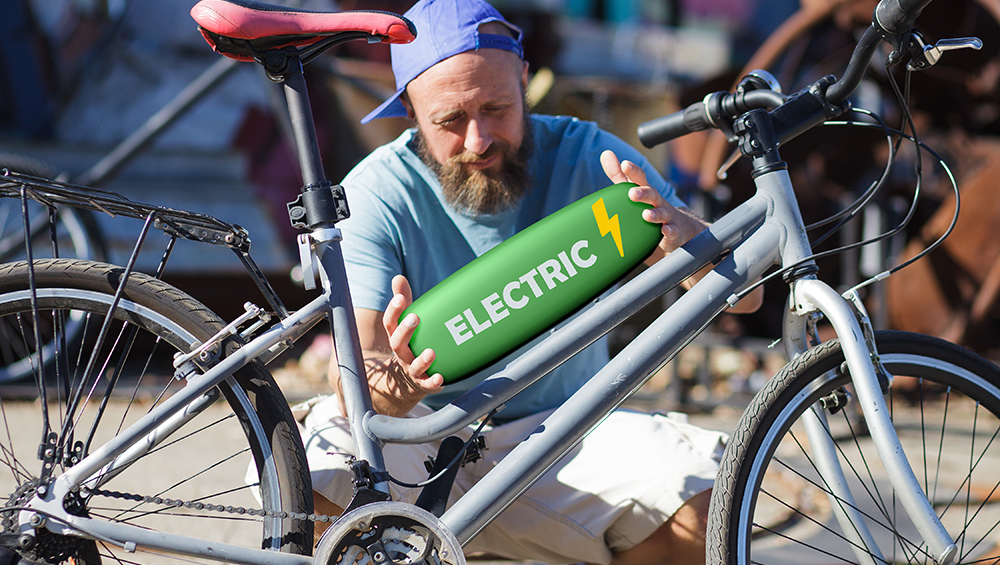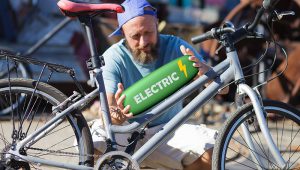10 Reasons to Try an E-Bike or E-Scooter
Don’t be surprised if the next bike that whizzes past you has a motor. Electric or e-bikes and e-scooters are becoming a more common sight on roads. In 2021, sales of e-bikes outpaced sales of electric cars. With high gas prices, more ride-share opportunities, and increased concerns about the environment, the trend isn’t likely to slow down.
“It’s considerably better than riding in my car to work,” says Kyle Timmerman, Ph.D., an avid road cyclist and physical activity researcher at Miami University of Ohio, who has researched e-bikes and uses one for his three-mile commute to work. “I’m trying to reduce my carbon footprint, and it’s another form of active transport. It lowers my intensity compared to riding my road bike, so I’m not sweaty when I arrive.”
For people with health issues or low fitness levels, riding a regular bike may too challenging, but “an e-bike overcomes those obstacles,” Dr. Timmerman says. “They can now incorporate this activity into their lifestyle. Maybe they do it for commuting or leisure, whereas if they just had a regular bike, they wouldn’t do it.”
The differences between e-bikes and e-scooters
E-bikes feature a motor that helps you pedal. Most e-bikes, except for class 2 types, don’t pedal for you but offer options for the amount of assistance. Since you are powering the bike, even if it’s at a low level, riding an e-bike is considered an active form of transportation and provide some physical activity benefits. The addition of the motor, however, makes the bikes heavier and bulkier than regular bikes and e-scooters, which may be a consideration if you plan to purchase one. They are also pricier. You can expect to pay around $1,500 to $2,500 for an entry-level e-bike.
Like e-bikes, e-scooters also have motors, but they’re lighter, less bulky, and cheaper than e-bikes. You can get a quality e-scooter for under $1,000. While you’re usually standing as you ride an e-scooter, it’s not considered active transport since you don’t have to do any work to move. So, while there are many benefits of using an e-scooter, you can’t count it as exercise, says Dr. Timmerman.
10 Reasons to Try an E-Bike or E-Scooter
Here are a variety of reasons to give one or both of these personal electric vehicles a try.
- Faster than walking or regular cycling. With speeds of about 20 mph, an e-bike or e-scooter will get you to your destination more quickly. In some cities, they could be quicker than driving a car.
- Save on gas. You’ll reduce wear and tear on your car, and you won’t have to fill up as often. Half of all trips people make are less than three miles—perfect for an e-bike or e-scooter. And most cost less than a penny per mile to charge.
- Provides exercise. Class 1 and 3 e-bikes require you to pedal to engage the motor. (Class 2 e-bikes can move even when you’re not pedaling.) Young adults riding e-bikes for three-mile commutes worked at a moderate intensity, making the activity qualify as exercise, according to a Miami University of Ohio study. Unfortunately, riding an e-scooter doesn’t count as physical activity since you’re not pedaling or doing any other type of activity.
- More practical for commuting. Not only will you get where you are going faster than walking or riding a regular bike, but you’ll also be less sweaty because you don’t have to work as hard.
- Better for the environment. When people own e-bikes or e-scooters, they drive less, decreasing greenhouse gases. An average gas-powered car generates 42 times more carbon emissions per mile compared to an e-bike.
- Ride-share programs make them easy to try. Many big cities, mid-size cities, and college campuses offer e-bikes, e-scooters, or both for rental through ride-share programs like Lime. You pick up an e-bike or e-scooter, helmet included, at one location and leave it at your destination. Many share programs have a $1 to $2 fee to unlock the bike or scooter and then charge by the minute, ranging from about $0.15 to $0.40. Prices vary by city.
- It gets you outdoors. Instead of being cooped up in a car, you can enjoy the wind blowing through your hair and the sunshine on your face. Being outdoors has been shown to reduce stress and improve mental health.
- Fewer parking issues. You won’t have to circle the parking lot looking for a spot when you’re on an e-bike or e-scooter. In most areas, you can park by the front door of your destination, either at a bike rack or out of the way of pedestrians. Some bikes and scooters have built-in locking devices and require an app to start them, so you don’t have to chain them to something.
- You’ll ride more. When people, who used regular bikes for some of their transportation, upgraded to e-bikes, they rode more than four times as many miles a day, according to a Norwegian study. On regular bikes, they averaged a little over a mile a day compared to nearly six miles a day when using an e-bike.
- It’s fun. Remember whizzing around town on a bike as a kid without a care in the world? E-bikes can bring back that sense of freedom and fun by overcoming many obstacles of riding a regular bike, like hills, long distances, or health problems. You’ll zip right up them with an e-bike or e-scooter. And if you like to go fast, both deliver with some models reaching 30 mph.
Before you hop on an e-bike or e-scooter, here are some tips to keep you—and those around you—safe while you ride.
Always wear a helmet. Even at slow speeds, crashes can cause serious injuries, which are a risk when riding.
Obey traffic rules. “That stop sign is still for you,” says Dr. Timmerman, who’s witnessed some riders ignoring them. Traffic signs and signals apply to all vehicles on the roads, not just cars.
Check local regulations. Some places have strict rules about where you can and can’t ride, and there are fines if you violate them. In many areas, e-bikes and e-scooters are prohibited from being on sidewalks. Some trails also restrict them depending on the type and size of the motor. The regulations in your area might affect the vehicle you decide to purchase.
Practice first. Learn how the e-bike or e-scooter works and how to use its features before hopping on. Then, get comfortable riding it in traffic-free or low-traffic areas before venturing into busier areas with more cars and pedestrians.
Learn proper hand signals. Signaling when you stop or turn lets cars know what you are doing, which can prevent accidents.
Wear brightly colored clothing. Motorists will be able to see you—and avoid you—more quickly.
Announce yourself. If you’re riding on paths or in areas where others may be walking or riding, alert others to your presence. Surprising someone as you pass could result in a collision.
Don’t drink and ride. It should go without saying, but in too many cases, people who are injured while riding an e-scooter or e-bike were intoxicated.
 Mindful Sodexo
Mindful Sodexo 


0 Comments